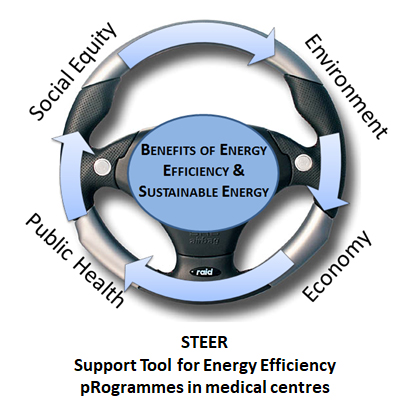
The STEER project’s strategic goal is to support the entire process of forecasting the effects of actions aimed at reducing energy consumption in medical centres.
The aim of STEER project is to create a tool that will provide medical centres and any other large institution involved in their energy efficiency programmes (governmental institutions, utilities providers, lending establishments, independent auditors, managers and technical staff), with information on the medical centre’s ideal energy consumption in different scenarios and on the most appropriate energy reduction plan for the medium-long term.
This project will be an excellent terrain to mix academic and professionals skills. The objective is to create an international dialogue and exchanges of experiences in the specific sophisticated domain of energy efficiency in medical centres and to reach the definition of best practises and to learn of more sophisticated statistic tools and techniques.
Overall STEER Project Structure
Phase 1 – Competence analysis , dissemination and communication strategy definition
Phase 2 – Model definition
Phase 3 – Testing and validation of models
Phase 4 – What-if analysis
Phase 5 – SW prototype development
Along the standard transfer of knowledge activities:
- Inventory of available knowledge and research on the main topic of STEER project;
- Joint research projects;
- Five ToK Workshops;
- Secondements;
- Networking activities.
Special measures will be taken to optimise this transfer of knowlede:
- Eight joint meetings, including Kick off meeting, a meeting to share informations, five ToK Workshop and the final Workshop;
- Lectures given by researchers involved in the project to all their department colleagues;
- Presentations given by private company staff involved in the project to all the divisions in the companies;
- Meeting once a year between a partners.
Scientific and Business benefits of Partnership
Short to medium term – scientific:
- Knowledge for energy efficiency assessments
- Study of best practises
- Expertise exchange and acquisition of new knowledge on methodology to evaluate
- Energy Efficiency measures
- Opportunity for pubblications
Short to medium term – business:
- Academia learns to manage intellectual property
- Attract the interest of companies in future breakthroughs during the exploitation actions
Long term term – scientific:
- Improving European scientific excellence in the area of energy efficiency analysis and evaluation
- Develop new inter sectorial collaboration
- Implementation of research results in the scientific strategy of the institutes
- Better reputation in the research field and reinforcement of the partner’s international profile
Long term term – business:
- Collaborations in R&D projects related to E3s
- Creation of commercial software tools for E3s
- Opening new academic reasearch pathways with industrial relevance to E3s
- Providing excellent experiences for the career development of the participating researcheres
- Joint participation in EU projects
- Concrete prospects fo patents
